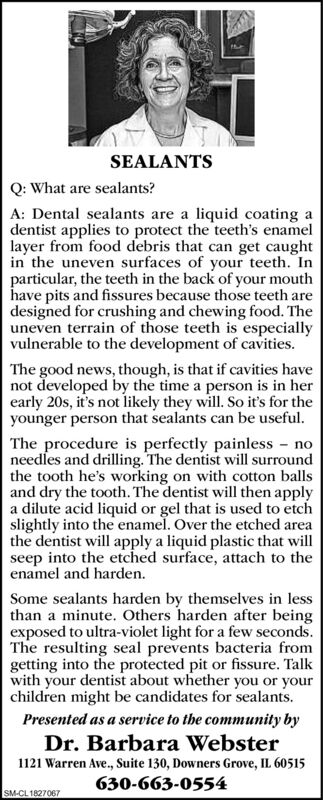Advertisement

-
Published Date
November 25, 2020This ad was originally published on this date and may contain an offer that is no longer valid. To learn more about this business and its most recent offers, click here.
Ad Text
SEALANTS Q: What are sealants? A: Dental sealants are a liquid coating a dentist applies to protect the teeth's enamel layer from food debris that can get caught in the uneven surfaces of your teeth. In particular, the teeth in the back of your mouth have pits and fissures because those teeth are designed for crushing and chewing food. The uneven terrain of those teeth is especially vulnerable to the development of cavities. The good news, though, is that if cavities have not developed by the time a person is in her early 20s, it's not likely they will. So it's for the younger person that sealants can be useful. The procedure is perfectly painless - no needles and drilling. The dentist will surround the tooth he's working on with cotton balls and dry the tooth. The dentist will then apply a dilute acid liquid or gel that is used to etch slightly into the enamel. Over the etched area the dentist will apply a liquid plastic that will seep into the etched surface, attach to the enamel and harden. Some sealants harden by themselves in less than a minute. Others harden after being exposed to ultra-violet light for a few seconds. The resulting seal prevents bacteria from getting into the protected pit or fissure. Talk with your dentist about whether you or your children might be candidates for sealants. Presented as a service to the community by Dr. Barbara Webster 1121 Warren Ave., Suite 130, Downers Grove, IL 60515 630-663-0554 SM-CL 1827067 SEALANTS Q: What are sealants? A: Dental sealants are a liquid coating a dentist applies to protect the teeth's enamel layer from food debris that can get caught in the uneven surfaces of your teeth. In particular, the teeth in the back of your mouth have pits and fissures because those teeth are designed for crushing and chewing food. The uneven terrain of those teeth is especially vulnerable to the development of cavities. The good news, though, is that if cavities have not developed by the time a person is in her early 20s, it's not likely they will. So it's for the younger person that sealants can be useful. The procedure is perfectly painless - no needles and drilling. The dentist will surround the tooth he's working on with cotton balls and dry the tooth. The dentist will then apply a dilute acid liquid or gel that is used to etch slightly into the enamel. Over the etched area the dentist will apply a liquid plastic that will seep into the etched surface, attach to the enamel and harden. Some sealants harden by themselves in less than a minute. Others harden after being exposed to ultra-violet light for a few seconds. The resulting seal prevents bacteria from getting into the protected pit or fissure. Talk with your dentist about whether you or your children might be candidates for sealants. Presented as a service to the community by Dr. Barbara Webster 1121 Warren Ave., Suite 130, Downers Grove, IL 60515 630-663-0554 SM-CL 1827067
